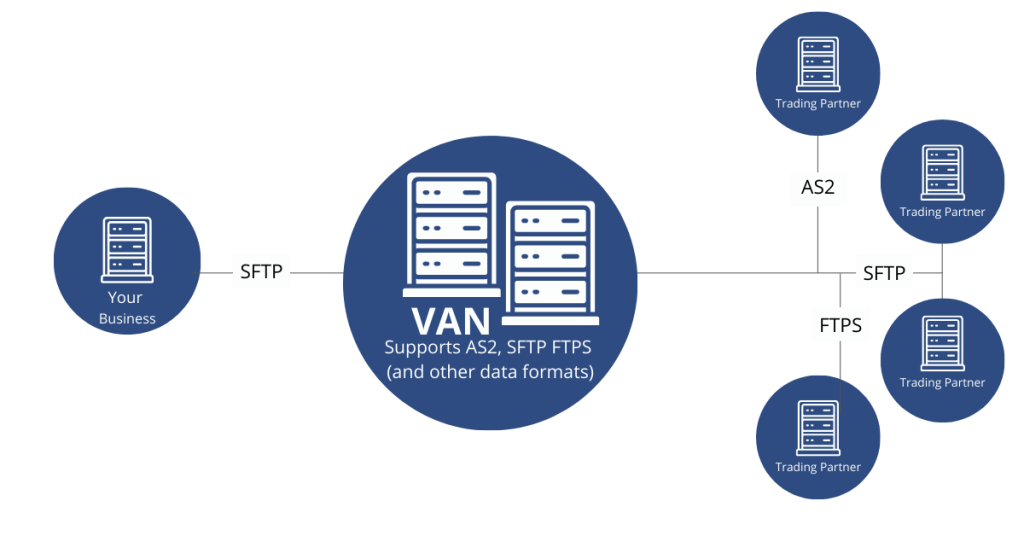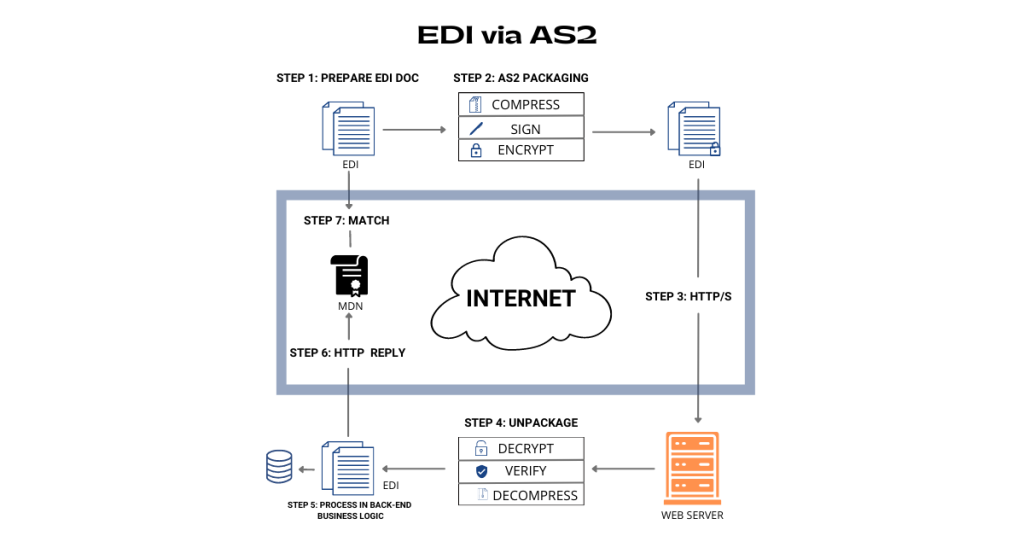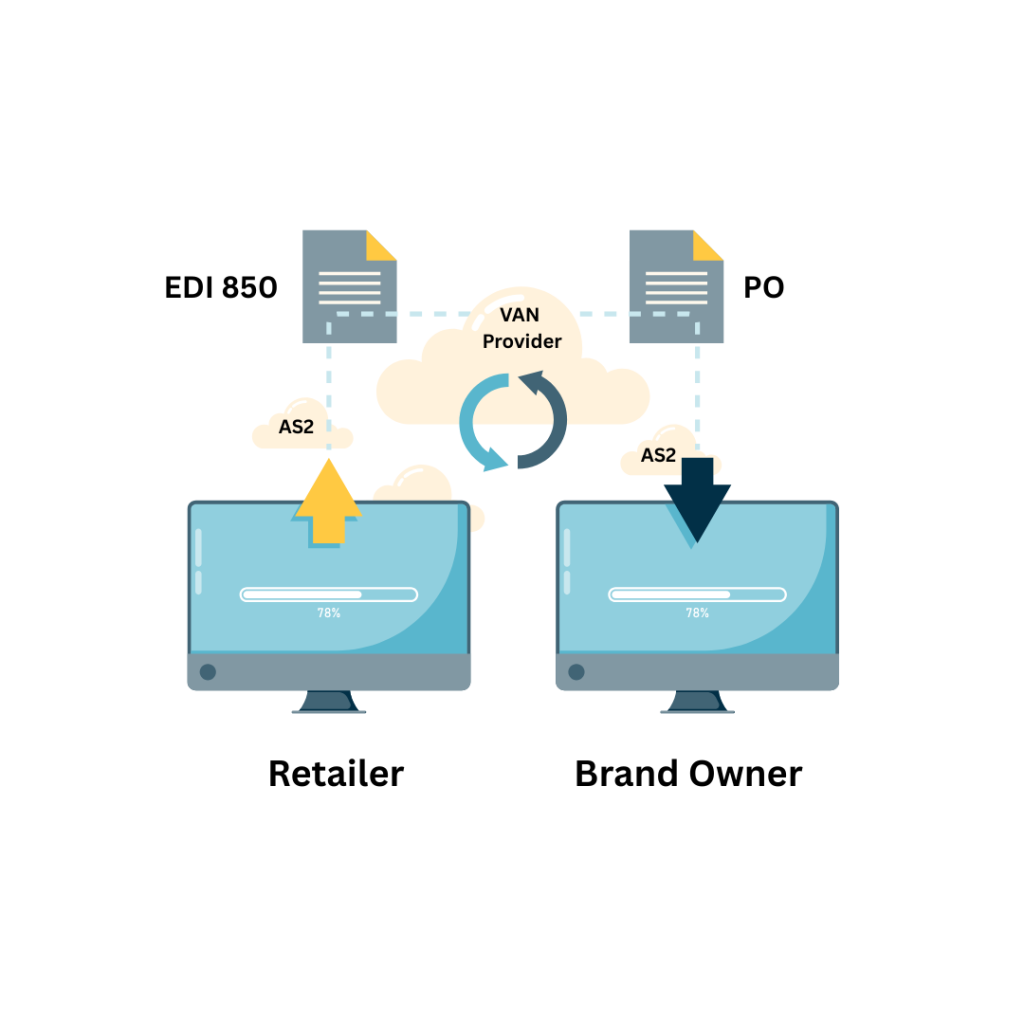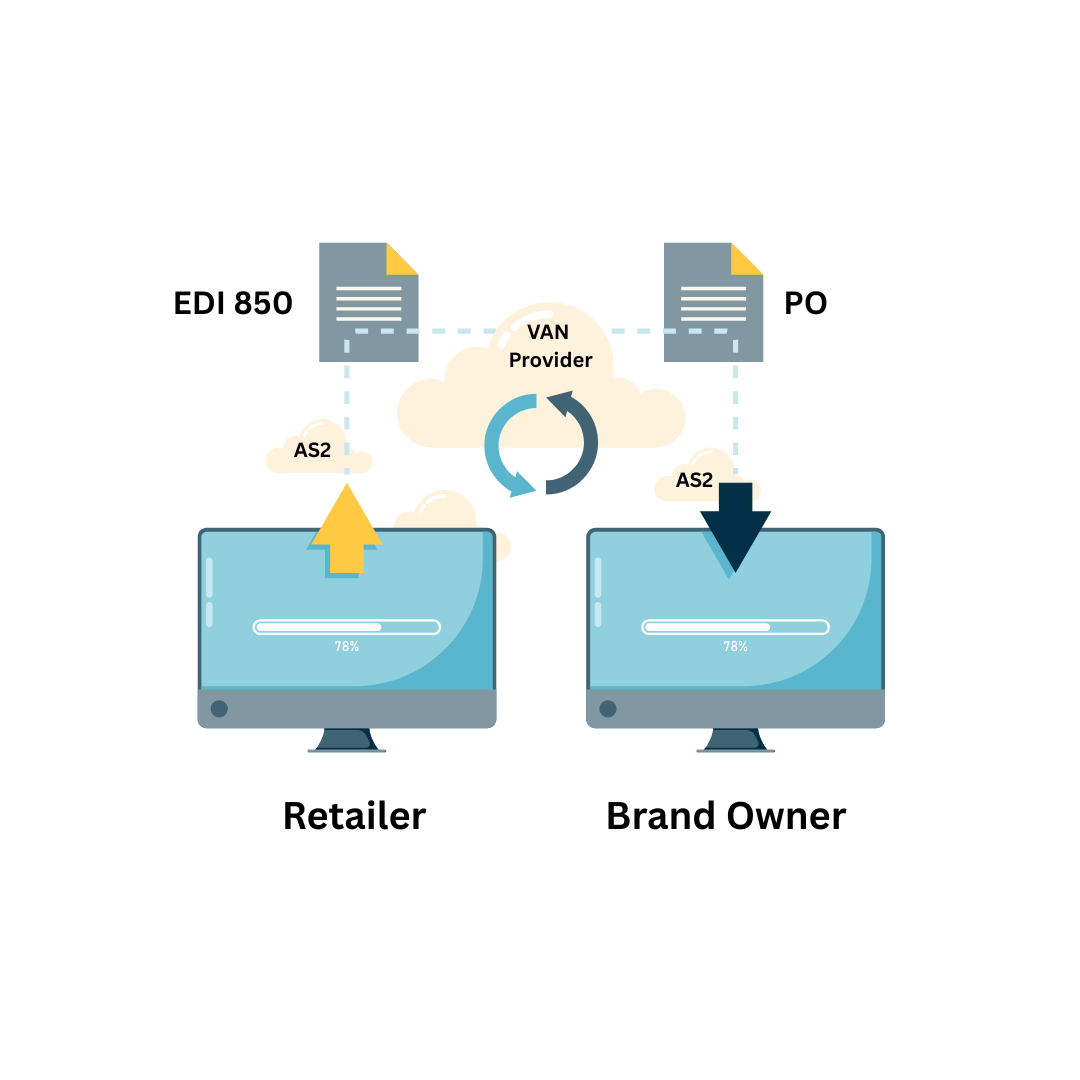Introduction
Electronic Data Interchange (EDI) technology facilitates billions of dollars in commercial transactions daily, eliminating paper-based processes and drastically reducing manual errors.
However, selecting the right method to transmit these critical EDI files remains a pivotal decision that can significantly impact operational efficiency, costs, and security.
The global electronic data interchange market has experienced remarkable growth, reaching a valuation of USD 36.52 billion in 2024, with projections indicating it will surge to USD 113.43 billion by 2034, representing a robust compound annual growth rate (CAGR) of 12% (Expert Market Research). This exponential growth underscores the increasing reliance businesses place on reliable EDI communication protocols.
When it comes to transmitting EDI files, organizations primarily face a crucial choice between two dominant communication methods: Value Added Networks (VAN) and Applicability Statement 2 (AS2) protocol.
Each approach offers distinct advantages, addressing different organizational needs, technical capabilities, and business requirements. Understanding the nuances of both VAN and AS2 communication protocols is essential for making an informed decision that aligns with your company’s strategic objectives.
This comprehensive guide explores the fundamental differences, advantages, limitations, and ideal use cases for both VAN and AS2, equipping you with the knowledge necessary to determine which solution best serves your EDI file transmission needs.
Key Takeaways
- Understanding Your Requirements is Fundamental: The decision between Value Added Network (VAN) and AS2 protocol hinges primarily on your organization’s specific context, including transaction volume, technical capabilities, trading partner requirements, and strategic priorities
- Cost Structures Differ Significantly: VAN services operate on a variable cost model where pricing changes based on the transaction volume, making them potentially more economical for all users. AS2 implementations involve primarily fixed costs, with expenses remaining relatively stable regardless of transaction volume, creating significant cost advantages for high-volume users, but initial setups can be expensive depending on the level of integrations.
- Technical Complexity and Control Present Trade-offs: VANs offer operational simplicity by handling infrastructure management, protocol translation, and trading partner coordination, making them attractive for organizations with limited IT resources or those preferring to outsource technical complexity. AS2 provides greater control and direct communication but requires more technical expertise to implement and maintain. Organizations must honestly assess their technical capabilities and determine whether they prefer operational convenience or direct control over their EDI infrastructure. The decision often reflects broader IT strategy regarding build versus buy and in-house versus outsourced operations.
- Trading Partner Considerations Significantly Influence the Decision: The characteristics of your trading partner ecosystem substantially impact which solution proves most effective. Organizations working with diverse partners using varied protocols may benefit from VAN’s translation capabilities, while those primarily working with AS2-capable partners in industries where AS2 is standard might find direct AS2 connectivity more efficient.
- Hybrid Approaches Offer Flexible Solutions: The VAN versus AS2 decision need not be binary. Many organizations successfully implement hybrid strategies that leverage both methods strategically, using AS2 for high-volume relationships where cost savings justify the implementation effort while maintaining VAN connectivity for smaller partners or those requiring specialized protocols. Hybrid approaches provide flexibility to optimize costs for major partnerships while retaining broad compatibility across diverse trading partner ecosystems.
Understanding Electronic Data Interchange (EDI)
Electronic Data Interchange represents the computer-to-computer exchange of business documents in a standardized electronic format between business partners. Rather than traditional methods involving paper documents, faxes, or emails, EDI enables the direct transmission of purchase orders, invoices, shipping notices, and other business documents from one organization’s computer system to another.
EDI transactions follow standardized formats such as ANSI X12, EDIFACT, TRADACOMS, and others, ensuring that disparate systems can interpret and process the exchanged data uniformly. However, the standardization of document formats is only one component of successful EDI implementation. The method by which these standardized documents travel from sender to receiver—the communication protocol—is equally critical and forms the basis of the VAN versus AS2 decision.
What is a Value Added Network (VAN)?
A Value Added Network (VAN) serves as a third-party managed network that acts as an intermediary between trading partners exchanging EDI documents. Think of a VAN as a sophisticated post office specifically designed for electronic business documents. Rather than organizations connecting directly to each other, they each connect to the VAN, which receives, validates, stores, and forwards EDI transactions to the appropriate recipients.

How VAN Works
The operational model of a VAN follows a straightforward yet effective process. When your organization needs to send an EDI document, you transmit it to your VAN provider via various communication protocols, such as FTP, FTPS, SFTP, or AS2. The VAN receives your document, performs validation checks to ensure proper formatting and compliance, and then routes it through the network to your trading partner’s VAN mailbox. Your trading partner subsequently retrieves the document from their mailbox at their convenience.
This store-and-forward mechanism provides a buffer between trading partners, eliminating the requirement for simultaneous availability. If your partner’s system is temporarily offline for maintenance or experiencing technical difficulties, your documents remain safely stored in the VAN until they can be retrieved.
Key Features of VAN
Value-added networks offer several distinguishing features that have maintained their relevance despite the emergence of alternative technologies. Protocol translation stands as one of the most valuable VAN capabilities. Since different organizations may use different communication protocols, VANs can receive data in one format and translate it to the format required by the receiving party, facilitating seamless communication across diverse technical environments.
Document storage and archival represent another critical advantage. VANs maintain copies of all transmitted documents for specified retention periods, providing an audit trail and enabling document retrieval when needed. This feature proves invaluable for compliance purposes and dispute resolution.
VANs also provide comprehensive trading partner management services. Establishing EDI connections with multiple partners can be administratively complex, involving numerous technical configurations and ongoing relationship management. VAN providers handle much of this complexity, offering a single connection point through which you can communicate with hundreds or thousands of partners.
Data security and encryption are standard offerings, with VANs implementing multiple layers of protection to safeguard sensitive business information during transmission and storage. Additionally, most VAN providers offer value-added services such as format conversion, data validation, compliance checking, and detailed transaction tracking and reporting.
Advantages of Using VAN
The benefits of Value Added Networks extend across multiple dimensions of business operations. Simplified connectivity emerges as perhaps the most immediate advantage. Rather than establishing and maintaining individual connections with each trading partner, organizations need only establish a single connection to their VAN provider. This dramatically reduces technical complexity, particularly for companies with extensive partner networks.
Protocol flexibility allows organizations to communicate with partners using different protocols without implementing multiple technical solutions internally. The VAN handles these variations transparently, abstracting away technical differences.
Reliability and uptime are hallmarks of established VAN providers. These networks typically offer robust infrastructure with redundancy built in, ensuring high availability and minimizing the risk of communication disruptions. The store-and-forward model also enhances reliability by accommodating temporary system unavailability.
Comprehensive support and services differentiate VAN providers from purely technical solutions. Most VANs offer extensive customer support, assisting with onboarding new trading partners, troubleshooting transmission issues, and providing consulting services for EDI implementation and optimization.
Compliance assistance is another valuable benefit. Many industries have specific EDI requirements and standards. VAN providers typically possess deep expertise in these requirements and can help ensure your transmissions meet necessary compliance standards.
Limitations of VAN
Despite their numerous advantages, Value Added Networks present certain limitations that organizations must carefully consider. Cost structure represents the primary concern for many businesses. VANs typically charge based on transaction volume, measured in kilocharacters (KC), and may also impose monthly subscription fees, per-partner charges, and fees for additional services. For high-volume users, these costs can accumulate substantially over time.
Ongoing operational expenses create a perpetual cost burden. Unlike one-time implementation costs for alternative solutions, VAN fees persist indefinitely, potentially increasing as transaction volumes grow. This recurring expense model can significantly impact the total cost of ownership over extended periods.
Dependency on third-party infrastructure introduces an element of reduced control. While VAN providers typically offer excellent uptime, organizations ultimately rely on the provider’s infrastructure, security measures, and business continuity. Any issues affecting the VAN provider can directly impact your ability to exchange EDI documents.
Potential speed considerations may arise in time-sensitive scenarios. The store-and-forward model, while providing reliability benefits, introduces latency compared to direct transmission methods. For most business processes, this delay is negligible; however, for applications requiring real-time or near-real-time data exchange, this latency might prove problematic.
Vendor lock-in concerns exist when extensive customizations or integrations are built specifically for a particular VAN provider. Migrating to alternative solutions or different VAN providers can require significant effort and investment, potentially limiting organizational flexibility.
Understanding AS2 Protocol
Applicability Statement 2 (AS2) represents a specification defining how to transport structured business-to-business data securely and reliably over the Internet. Developed by the Internet Engineering Task Force (IETF) in 2002 as a successor to AS1, AS2 has become one of the most widely adopted protocols for EDI transmission, particularly in retail, automotive, and fast-moving consumer goods industries.

How AS2 Works
AS2 operates fundamentally differently from VANs, facilitating direct, point-to-point communication between trading partners over the Internet. The protocol leverages standard HTTP/HTTPS protocols for data transmission, combined with S/MIME (Secure/Multipurpose Internet Mail Extensions) for encryption and digital signatures.
When transmitting an EDI document via AS2, the sending system packages the data, applies encryption using the recipient’s public certificate, adds a digital signature using the sender’s private certificate for authentication, and transmits the encrypted package directly to the recipient’s AS2 server via HTTPS. The receiving system decrypts the data using its private certificate, verifies the sender’s signature using the sender’s public certificate, processes the EDI document, and returns a Message Disposition Notification (MDN) acknowledging receipt.
This MDN mechanism provides non-repudiation, confirming that the intended recipient successfully received and processed the transmission. MDNs can be synchronous (returned immediately during the same connection) or asynchronous (returned separately after processing).
Key Features of AS2
AS2 protocol incorporates several sophisticated features that address security, reliability, and compliance requirements. End-to-end encryption ensures that EDI data remains confidential during transmission, with data encrypted at the source and decrypted only at the destination, preventing interception and unauthorized access.
Digital signatures provide authentication and data integrity verification. Recipients can confirm the sender’s identity and detect any tampering or corruption during transmission, essential capabilities for high-value business transactions.
Message Disposition Notifications (MDNs) offer delivery confirmation and non-repudiation. These receipts provide proof of successful delivery and acceptance, creating an audit trail for compliance and dispute resolution purposes.
Compression capabilities enable efficient bandwidth utilization, particularly valuable when transmitting large EDI files or operating in bandwidth-constrained environments. The protocol supports various compression algorithms to optimize transmission efficiency.
Reliability features include automatic retry mechanisms and error handling. AS2 implementations typically incorporate logic to automatically retry failed transmissions and handle various error conditions gracefully, enhancing overall reliability.
Advantages of Using AS2
The benefits of the AS2 protocol have driven its widespread adoption across numerous industries. Cost efficiency stands out as a primary advantage, particularly for high-volume users. Once implemented, AS2 involves no per-transaction fees beyond standard Internet connectivity costs. Organizations pay only for their AS2 software or service subscription, regardless of transaction volume, making it highly economical for businesses with substantial EDI traffic.
Direct communication eliminates intermediary dependencies. Organizations connect directly with trading partners, reducing latency and maintaining greater control over the transmission process. This direct connection enhances speed and simplifies troubleshooting when issues arise.
Enhanced security through built-in encryption and digital signatures ensures data confidentiality and integrity without requiring additional security layers. The protocol’s security mechanisms have been extensively tested and proven in demanding production environments.
Real-time transmission capability enables immediate data exchange, supporting time-sensitive business processes. Unlike store-and-forward models, AS2 facilitates near-instantaneous document delivery when both parties’ systems are operational.
Industry standardization has made AS2 a de facto standard in several sectors. Retail adoption of AS2 remains particularly high, with major retailers requiring their suppliers to support AS2 communication. This widespread acceptance ensures compatibility across diverse trading partner ecosystems.
Scalability represents another significant advantage. AS2 infrastructure can handle growing transaction volumes without proportional cost increases, making it attractive for rapidly expanding businesses or those anticipating significant growth.
Limitations of AS2
While AS2 offers compelling advantages, organizations must also consider its limitations and challenges. Implementation complexity requires technical expertise. Unlike VAN services that handle technical details, AS2 implementation demands in-house technical capabilities or engagement with specialized service providers. Organizations must configure AS2 servers, manage certificates, establish connections with each trading partner, and maintain the infrastructure.
Trading partner coordination is becoming more involved with AS2. Each trading partner relationship requires bilateral configuration, including certificate exchange, connection testing, and ongoing maintenance. Organizations with numerous trading partners must invest considerable effort in this coordination.
Infrastructure requirements include maintaining AS2 server infrastructure, whether on-premises or cloud-based. This involves ensuring adequate hardware resources, implementing proper security measures, maintaining high availability, and managing software updates and patches.
Certificate management introduces administrative overhead. AS2 relies on digital certificates for encryption and authentication, requiring organizations to obtain, renew, exchange, and revoke certificates as needed. Expired or improperly configured certificates can disrupt communications.
Limited value-added services characterize pure AS2 implementations. Unlike VAN providers that offer additional services such as data translation, compliance checking, and comprehensive reporting, AS2 provides only the communication protocol. Organizations must implement additional solutions for these capabilities if needed.
VAN vs AS2: Comprehensive Comparison
Understanding the fundamental differences between VAN and AS2 requires examining multiple dimensions of their operational characteristics, costs, and suitability for different business contexts.
Feature | VAN | AS2 |
|---|---|---|
Cost Model | Variable (per transaction/KC) + monthly fees | Fixed (software/service subscription) |
| Initial Investment | Starts at as low as $250/month | Moderate to High ($1,000-$5,000 setup) |
| Ongoing Costs | Starts from as low as ($300 /month), grows gradually as volume and KCs increase | Predictable ($500-$3,000/month regardless of volume) |
| Implementation Complexity | Simple – Managed by provider | Complex – Requires technical expertise |
| Setup Time | Quick (days to weeks) | Longer (weeks to months) |
| Technical Expertise Required | Minimal | Moderate to high |
| Trading Partner Connectivity | Single connection to VAN hub | Individual connection to each partner |
| Protocol Support | Multiple (AS2, FTP, FTPS, sFTP, etc) | AS2 Only |
| Data Transmission | Store-and-forward (asynchronous) | Direct, real-time (synchronous or asynchronous) |
| Speed/Latency | Moderate (multi-hop processing) | Fast (direct transmission) |
| Security | Managed by VAN provider | Built-in encryption and digital signatures |
| Control | Limited (third-party managed) | Full control over infrastructure |
| Scalability | Easy to scale, low costs | Cost increases as you want to scale |
| Infrastructure Management | Handled by VAN provider | Organization’s responsibility |
| Value-Added Services | Extensive (translation, validation, reporting) | Limited (communication only) |
| Trading Partner Onboarding | Simple (VAN handles coordination) | Limited (communication only) Complex (bilateral coordination required) |
| Uptime/Reliability | High (provider SLAs) | Depends on implementation |
| Document Storage | Included (archive and audit trail) | Must implement separately |
| Compliance Support | Built-in compliance assistance | Self-managed compliance |
Technical Comparison
From a technical perspective, VAN and AS2 represent different architectural approaches. VANs operate as centralized hub-and-spoke models, with the VAN provider serving as the hub through which all communications flow. This architecture simplifies individual trading partner connections but creates a central point of dependency.
AS2 implements a distributed, peer-to-peer model where organizations connect directly with each other. This decentralized approach eliminates intermediary dependencies but requires managing multiple individual connections.
Regarding protocols and compatibility, VANs support multiple communication protocols, including AS2, FTP, FTPS, SFTP, HTTP/HTTPS, and proprietary protocols. This flexibility enables communication with partners using diverse technologies. AS2 specifically utilizes HTTP/HTTPS for transport with S/MIME for security, requiring both parties to support the AS2 specification.
Security implementations differ in approach. VANs provide security through their managed infrastructure, implementing encryption during transit and at rest, access controls, and monitoring. Users trust the VAN provider’s security measures and certifications. AS2 builds security directly into the protocol through end-to-end encryption and digital signatures, giving organizations direct control over security implementation.
Performance characteristics reveal distinct profiles. VAN transmission involves multiple hops (sender to VAN, processing at VAN, VAN to recipient), introducing latency. However, the store-and-forward model provides resilience to temporary unavailability. AS2 enables direct, real-time transmission with minimal latency when both systems are available, though simultaneous availability is required for synchronous operations.
Management and Maintenance
Operational management requirements differ substantially between VAN and AS2 solutions. VAN providers handle most infrastructure management, including server maintenance, software updates, security patches, monitoring and troubleshooting, and capacity planning. Users focus primarily on internal integration and document preparation.
AS2 implementation places greater operational responsibility on the organization. Whether operating on-premises infrastructure or utilizing managed AS2 services, organizations must ensure proper configuration, monitor system health, manage certificate lifecycles, coordinate with trading partners for connection issues, and implement proper backup and disaster recovery procedures.
Trading partner onboarding follows different processes. With VANs, adding a new trading partner typically involves contacting the VAN provider, providing partner information, and allowing the VAN to establish connectivity. The VAN handles technical coordination and testing. For AS2, onboarding requires bilateral coordination, including certificate exchange, AS2 endpoint configuration, connection testing and validation, and agreement on operational parameters such as MDN requirements and retry policies.
Scalability Considerations
Scalability characteristics influence long-term strategic planning. VANs offer straightforward scalability from a technical perspective. As transaction volumes grow, the VAN infrastructure automatically accommodates increased traffic. However, costs scale proportionally with volume, potentially becoming prohibitive for very high-volume users.
AS2 provides excellent scalability at minimal incremental cost. Once infrastructure is properly sized, handling increased transaction volumes requires primarily additional computing resources. Modern cloud-based AS2 solutions offer elastic scalability, automatically adjusting capacity to meet demand. Cost increases are limited to infrastructure scaling rather than per-transaction fees.
Use Cases: When to Choose VAN
Certain organizational profiles and business contexts make VAN the optimal choice for EDI file transmission. Small to medium-sized businesses with limited IT resources often find VANs attractive. These organizations benefit from outsourcing technical complexity to the VAN provider, allowing them to focus on core business operations rather than EDI infrastructure management.
Companies with diverse trading partner ecosystems spanning multiple industries and using varied protocols benefit from VAN protocol flexibility. Rather than implementing multiple communication methods, organizations can leverage the VAN’s translation capabilities to communicate uniformly with all partners.
Businesses requiring extensive value-added services such as format translation, compliance validation, comprehensive reporting and analytics, and document archival find these capabilities readily available through VAN providers without additional implementation effort.
Organizations with moderate EDI transaction volumes may find VAN costs reasonable relative to the effort required to implement and maintain alternative solutions. The convenience and support provided by VANs justify the transaction-based pricing for businesses not transmitting massive volumes.
Companies operating in highly regulated industries where compliance documentation and audit trails are critical appreciate the comprehensive record-keeping and compliance support offered by established VAN providers. These providers typically maintain certifications relevant to various industries and regulatory frameworks.
Businesses experiencing rapid trading partner growth benefit from VANs’ simplified onboarding processes. The ability to quickly establish connectivity with new partners through the VAN’s existing infrastructure accelerates time-to-value for new business relationships.
Use Cases: When to Choose AS2
Alternatively, AS2 proves ideal for specific organizational contexts and requirements. High-volume EDI users achieve substantial cost savings through AS2’s fixed-cost model. Organizations transmitting millions of EDI documents annually can realize dramatic reductions in communication costs compared to per-transaction VAN pricing.
Large enterprises with robust IT departments possessing technical expertise can implement and manage AS2 infrastructure effectively. These organizations have the resources to handle implementation complexity and ongoing maintenance, maximizing AS2’s cost advantages.
Companies prioritizing direct trading partner relationships and desiring greater control over communication processes benefit from AS2’s peer-to-peer architecture. This direct connectivity facilitates stronger partner collaboration and faster issue resolution.
Organizations with time-sensitive business processes requiring real-time or near-real-time data exchange leverage AS2’s immediate transmission capabilities. Industries such as retail replenishment, just-in-time manufacturing, and time-critical logistics particularly benefit from this capability.
Businesses operating primarily within industries where AS2 has achieved standard status, particularly the retail and automotive sectors, find widespread partner support for AS2. Major retailers, including Walmart, Target, and others, require AS2 capability from their suppliers, making it essential for serving these customers.
Companies seeking to eliminate ongoing per-transaction costs and achieve predictable EDI communication expenses prefer AS2’s cost structure. This predictability facilitates more accurate budgeting and financial planning.
Organizations with strong security requirements and a preference for maintaining direct control over encryption and authentication mechanisms find AS2’s built-in security features appealing. The ability to implement security policies directly rather than relying on third-party security measures provides greater assurance for security-conscious businesses.
Hybrid Approaches: Best of Both Worlds
Recognizing that the VAN versus AS2 decision need not be absolute, many organizations implement hybrid approaches that leverage the strengths of both methods. This pragmatic strategy addresses diverse requirements across different trading partner relationships and business contexts.
A common hybrid model involves using AS2 for high-volume, established trading partners while maintaining VAN connectivity for smaller partners or those requiring protocols AS2 doesn’t support. This approach optimizes costs for major partnerships while retaining flexibility for diverse partner requirements.

Some organizations utilize VAN-provided AS2 services, combining AS2’s cost efficiency with VAN-provided management and support. These services offer AS2 connectivity with the convenience of VAN administration, representing a middle ground between pure VAN and self-managed AS2 implementations.
Another hybrid approach involves implementing AS2 for outbound transmissions to major partners while receiving inbound documents through a VAN. This asymmetric model optimizes costs for high-volume outbound traffic while maintaining broad inbound compatibility.
Organizations might also use AS2 as their primary method while maintaining VAN connectivity as a backup or for legacy partners not yet transitioned to AS2. This strategy provides redundancy and ensures continuous communication capability during transitions.
Implementation Best Practices
For VAN implementations
Conduct a thorough provider evaluation, comparing capabilities, pricing structures, industry expertise, customer support quality, security certifications, and the size of the trading partner network. Select a provider aligned with your industry and requirements.
Clearly define integration requirements, specifying how your internal systems will connect to the VAN, what document formats you’ll transmit and receive, and what reporting and visibility capabilities you require. Clear requirements prevent misunderstandings and ensure timely implementation.
Establish comprehensive testing procedures before going live. Test with critical trading partners in controlled environments, validate error handling and exception scenarios, and verify document formatting and data accuracy.
For AS2 implementations
Invest in proper infrastructure planning. Determine whether to deploy on-premises servers, utilize cloud infrastructure, or engage a managed AS2 service provider. Ensure adequate computing resources, network bandwidth, and storage capacity.
Implement robust certificate management processes from the outset. Establish procedures for certificate acquisition, secure storage, timely renewal, and partner certificate management. Certificate-related issues are among the most common AS2 problems, making solid management practices essential.
Develop comprehensive trading partner onboarding procedures. Create standardized processes for information exchange, connection configuration and testing, documentation, and support escalation. Efficient onboarding accelerates partner connectivity and reduces errors.
Implement thorough monitoring and alerting. Deploy tools to monitor transmission success rates, system performance and availability, certificate expiration dates, and error conditions. Proactive monitoring prevents issues from escalating into business disruptions.
For both approaches, maintain comprehensive documentation including system configurations, trading partner details, troubleshooting procedures, and operational runbooks. Documentation proves invaluable for training, troubleshooting, and business continuity.
Conclusion
The choice between Value Added Network (VAN) and AS2 protocol for transmitting EDI files represents a significant strategic decision with long-term implications for operational efficiency, costs, and trading partner relationships. Both approaches have proven their effectiveness across countless organizations and industries, each offering distinct advantages suited to different business contexts.
Ultimately, the most successful EDI implementations result from careful evaluation of organizational needs, thorough planning, proper implementation, and ongoing optimization. Whether you choose VAN, AS2, or a hybrid approach, commitment to best practices and continuous improvement will ensure your EDI infrastructure effectively supports your business objectives.
Commport Value Added Network - #1 EDI VAN With 99.99% Uptime
Download: VAN Buyers Guide
Maximize your business efficiency with the right VAN provider! Grab your free VAN Buyer's Guide and discover the key features and services that will elevate your EDI transactions to the next level.
Make an informed decision today!
Frequently Asked Questions
The fundamental difference lies in their architecture and cost structure. VAN is a third-party managed service that acts as an intermediary hub between trading partners using a store-and-forward model with variable, per-transaction pricing. AS2 is a direct, point-to-point communication protocol that enables real-time data exchange between partners with fixed-cost implementation. VANs offer simplicity and comprehensive services, while AS2 provides cost efficiency for high-volume users and direct control over communications.
Yes, and many organizations do exactly this through hybrid approaches. Companies commonly use AS2 for high-volume trading partners where cost savings justify the implementation effort, while maintaining VAN connectivity for smaller partners or those requiring different protocols. This hybrid strategy optimizes costs for major relationships while retaining flexibility across diverse trading partner ecosystems. Some businesses also use VAN-provided AS2 services, combining AS2’s efficiency with VAN’s management convenience.
VAN implementation is typically faster, often taking days to a few weeks. The VAN provider handles most technical complexity, requiring only basic integration with your internal systems. AS2 implementation is more time-intensive, usually requiring several weeks to several months depending on infrastructure choices, internal technical expertise, and the number of trading partners to onboard. The extended timeline accounts for server setup, certificate acquisition, trading partner coordination, comprehensive testing, and staff training.
Yes, AS2 requires moderate to high technical expertise for implementation and ongoing management. Your IT team needs knowledge of network protocols, digital certificates, encryption, server configuration, and troubleshooting capabilities. However, managed AS2 service providers can reduce this burden by handling infrastructure management while you maintain control over trading partner relationships. VANs require minimal technical expertise since the provider manages all technical aspects, making them suitable for organizations with limited IT resources.
MDNs are digital receipts in AS2 that confirm successful message delivery and processing. When you send an EDI document via AS2, the receiving system returns an MDN acknowledging receipt, verifying the sender’s identity, confirming data integrity, and providing a timestamp. MDNs offer non-repudiation—proof that the intended recipient received the transmission—creating an audit trail for compliance and dispute resolution. MDNs can be synchronous (returned immediately during the same connection) or asynchronous (returned separately after processing).
Yes, many VAN providers now offer AS2 as one of their supported protocols, creating a hybrid solution. These VAN-provided AS2 services let you leverage AS2’s cost efficiency while benefiting from the VAN’s management, support, and value-added services. This approach offers a middle ground between pure VAN (highest cost, lowest complexity) and self-managed AS2 (lowest cost, highest complexity). Organizations using VAN-provided AS2 typically pay lower per-transaction fees than traditional VAN protocols while avoiding the burden of managing AS2 infrastructure internally.
AS2 requires digital certificates for encryption and authentication. You need an X.509 digital certificate for your organization, typically obtained from a Certificate Authority (CA) like DigiCert, GlobalSign, or Comodo. Certificates include a public key (shared with trading partners for encrypting data they send to you) and a private key (kept secure, used to decrypt incoming data and sign outgoing data). You’ll also need to exchange and store public certificates from each trading partner. Certificates have expiration dates (typically 1-3 years) requiring renewal. Proper certificate management, including secure storage, timely renewal, and organized partner certificate tracking, is essential for uninterrupted AS2 operations.
AS2 enables near-real-time, synchronous communication when both parties’ systems are operational. When you transmit a document via AS2, it travels directly to the recipient’s server immediately, typically completing within seconds. However, “real-time” depends on both systems being available simultaneously. If the recipient’s system is offline, AS2 implementations typically include retry mechanisms that will automatically reattempt delivery when the system becomes available. This differs from VAN’s store-and-forward model, where the VAN holds documents until the recipient retrieves them, which may introduce hours or days of delay depending on the recipient’s polling schedule.
VAN providers typically offer comprehensive reporting dashboards showing transaction volumes, success and failure rates, trading partner activity, document types transmitted, audit trails and compliance reports, and billing details. These reports are provided as part of the VAN service. AS2 implementations vary in reporting capabilities depending on the solution chosen. Managed AS2 services usually include robust reporting, while self-deployed solutions require implementing monitoring and reporting tools separately. Organizations may need to integrate AS2 logs with business intelligence tools to achieve reporting comparable to VAN providers. This represents another trade-off between VAN’s included services and AS2’s lower ongoing costs.





